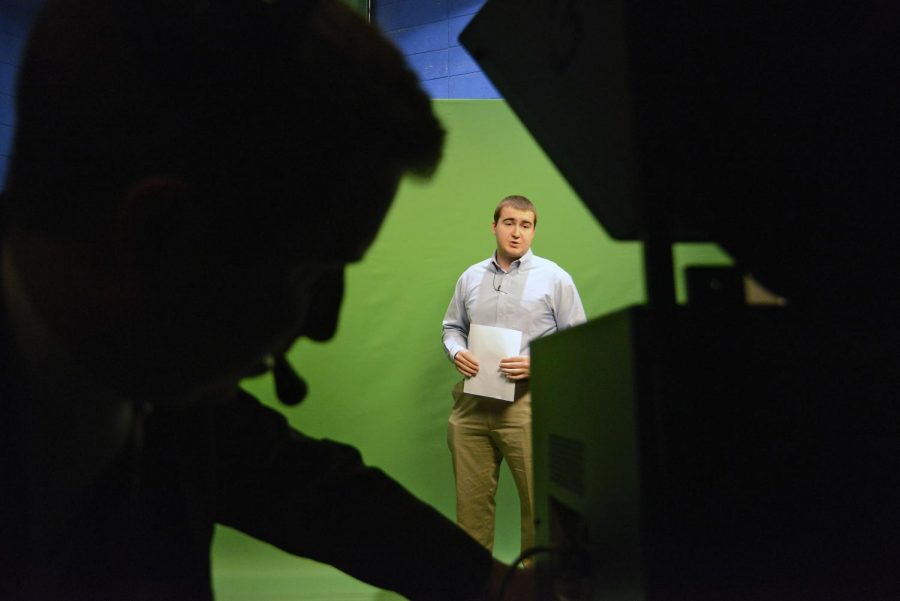Meteorology students predict their future in forecasting
March 3, 2015
Snowmageddon. Snowpocalypse. Or, in the analytic mind of a meteorologist, simply a record-setting winter storm. Two weeks ago, these ingredients incited a week filled with snow and freezing temperatures, as well as a closed WKU campus.
According to the National Weather Service, Feb. 16 was the seventh snowiest day on record for Bowling Green, accumulating 12.6 inches, as well as reaching some of the lowest temperatures on Feb. 19, at minus 7 degrees.
The public had mixed feelings about the town’s wintry paralysis, but for meteorology students, it provided an opportunity to test out their forecasting abilities.
“We were able to forecast the event fairly well and in advance of it,” Josh Durkee, associate professor of meteorology/geography, said. “It makes it exciting when we make these predictions and then we are able to verify that what we did was correct.”
The processes that go into predicting weather events require thorough calculations and intuition. Meteorologists interpret various weather prediction models that are pieced together by computed amounts of information received from different stations.
The issue with these weather models stem from the stations having varying degrees of preciseness, dependent upon equipment, as well ways the information is interpreted.
Because these systems all contain flaws, a lot of room for error exists that meteorologists must muddle through.
“The job of a forecaster is to interpret all those flaws, take all the pros, take all the cons and use their understanding of meteorology to give their interpretation of those interpretations,” Durkee said.
In the past, the typical weatherman on TV could easily not have a meteorology background. Durkee explained that it wasn’t uncommon for a normal broadcaster to be given the role of weather forecaster and simply read off the weather maps that the news station received.
However, at WKU a sizeable amount of meteorology students are choosing a background in broadcasting as well in order to serve the public with reputable weather information. One such group is practicing this during their college years.
Formed in the late 1990s, the WKU Storm Team’s mission statement looks to practice accurate prediction and serving the Bowing Green community.
Henderson senior and team manager Caleb Chevalier said the goal “is to keep the campus safe, and the community of Bowling Green safe and we’ve expanded that to a whole listening area.”
During important weather events, like thunderstorms, tornadoes and this anomalous winter storm, the Storm Team utilizes multiple forms of media to transmit information, via the campus radio station Revolution 91.7, News Channel 12 and Twitter.
Chevalier had always been interested in weather as a child, and he enjoyed performing in choir and church plays. A minor in broadcasting was appealing because of a desire to serve the community through the exhibition of what he knew.
“I felt that broadcast was the best avenue, you could say, to tackle that,” he said.
After beginning to actually study the science, Chevalier found meteorology to be a lot more complex than he once thought.
“I knew there was a lot that I didn’t know… but it really does sweep you off your feet, and make you step back a little bit,” he said. “It’s a very difficult major, but it’s a very rewarding one at the same time.”
According to the American Meteorological Society, many meteorologists are employed by the federal government, particularly within NOAA, the National Oceanic and Atmospheric Administration. Most weather data in America is free to the public. Europe, on the other hand, sells their data, but they have a higher resolution model and integrate information differently. The United States’ global weather model was just updated in January to be similar to Europe’s, but the continent is working to have higher performing technology all the same. Durkee said it is a lot like the race to the moon.
The accuracy of American weather forecasting could be improved upon if more money was dedicated to better technology and equipment. However, “a lot of people don’t believe that the weather sector is important as it is,” Durkee said. But agriculture, infrastructure,and the overall economy can be massively affected if a severe drought or hurricane were to wreak havoc on a region.
Durkee hopes that as technology improves and time goes on, the standard three-day to five-day weather forecast can increase to a week-long forecast with the same degree of accuracy. Forty years ago, a one to two-day forecast was about as precise as meteorologists and their equipment could be without making dramatic conjectures. Another common goal is to bridge the gap between the information and the public.
“We’re trying to get the public prepared, and save lives, like in the event of a winter storm like the one we just had,” Chevalier said. “Meteorologists at the national and local level are frantically trying to figure out the best way to communicate that, because right now, we’re only doing an okay job, to be honest.”
And even though the common joke is to ‘blame it on the weatherman’ when weather forecasts prove to be incorrect, Durkee said meteorologists aim to be less and less wrong. This is something he tries to impart on his students.
“A good meteorologist has to be humble,” Chevalier said. “A good meteorologist knows how to learn from their mistakes, how to take it in stride.”





















![Megan Inman of Tennessee cries after embracing Drag performer and transgender advocate Jasmine St. James at the 9th Annual WKU Housing and Residence Life Drag Show at Knicely Conference Center on April 4, 2024. “[The community] was so warm and welcoming when I came out, if it wasn’t for the queens I wouldn’t be here,” Inman said.](https://wkuherald.com/wp-content/uploads/2024/04/smith_von_drag_3-600x419.jpg)


